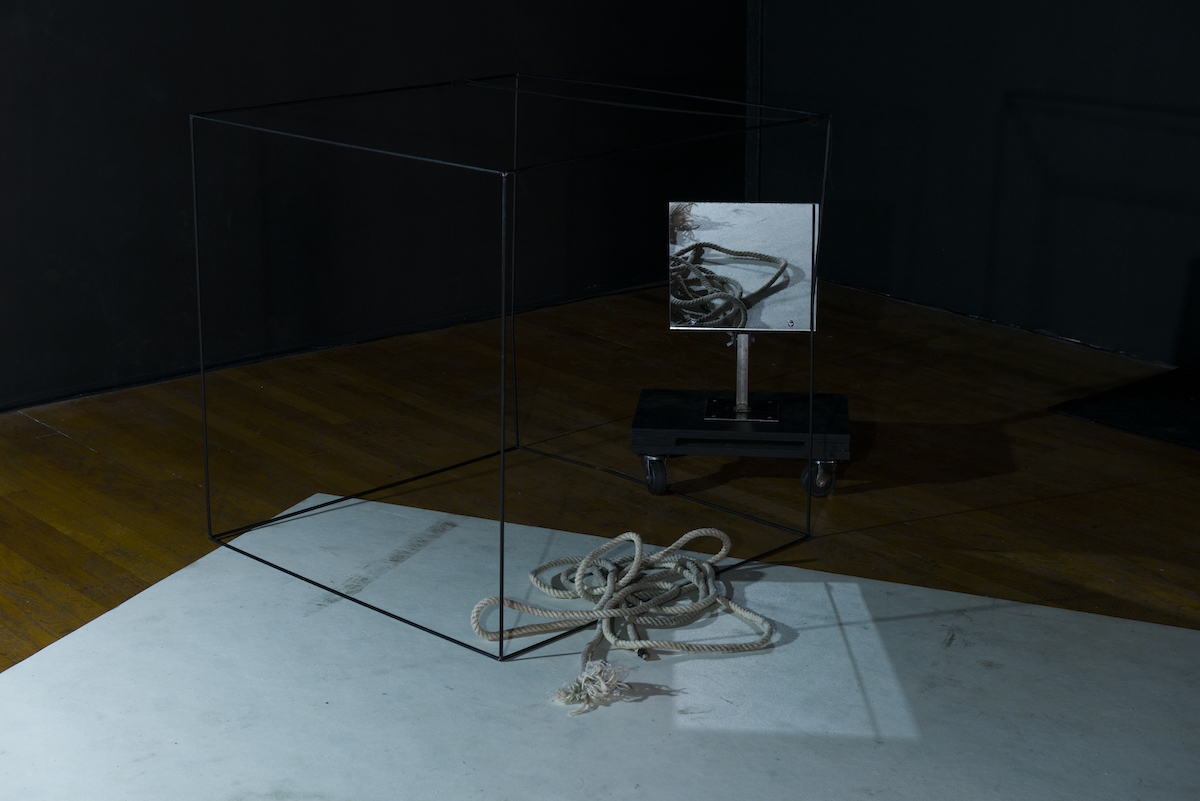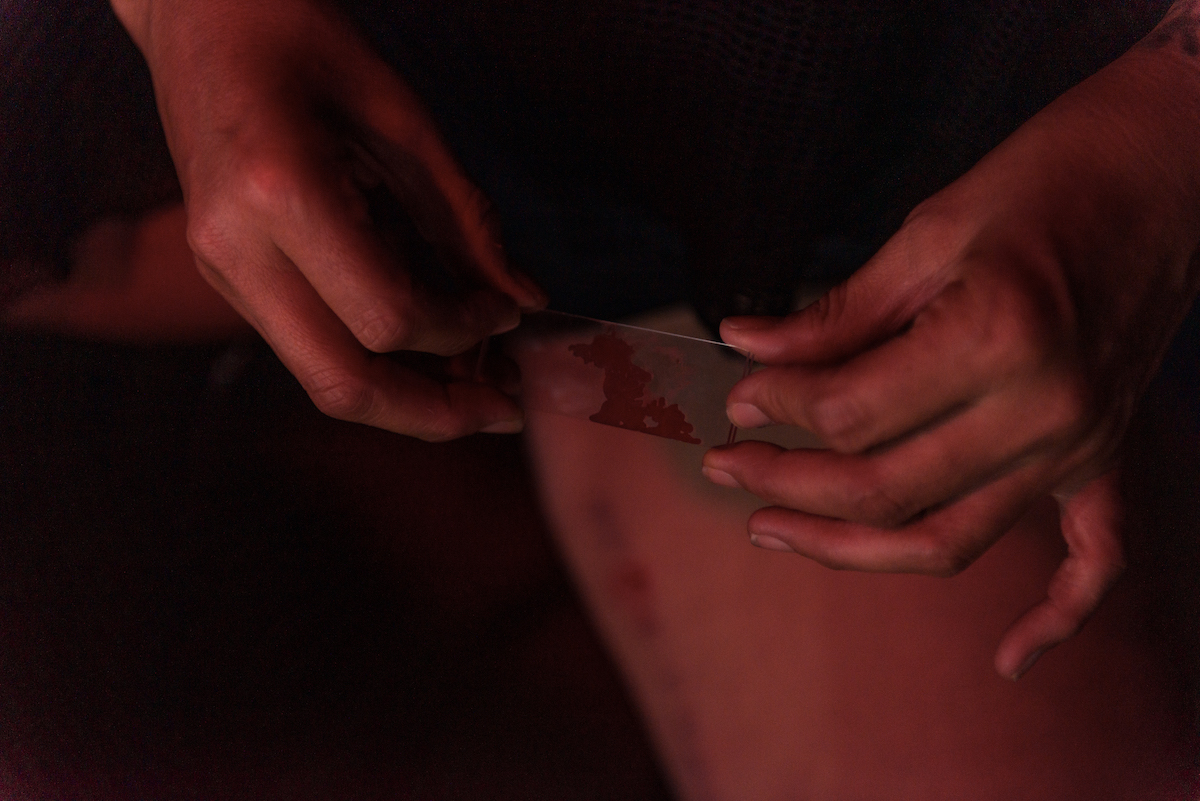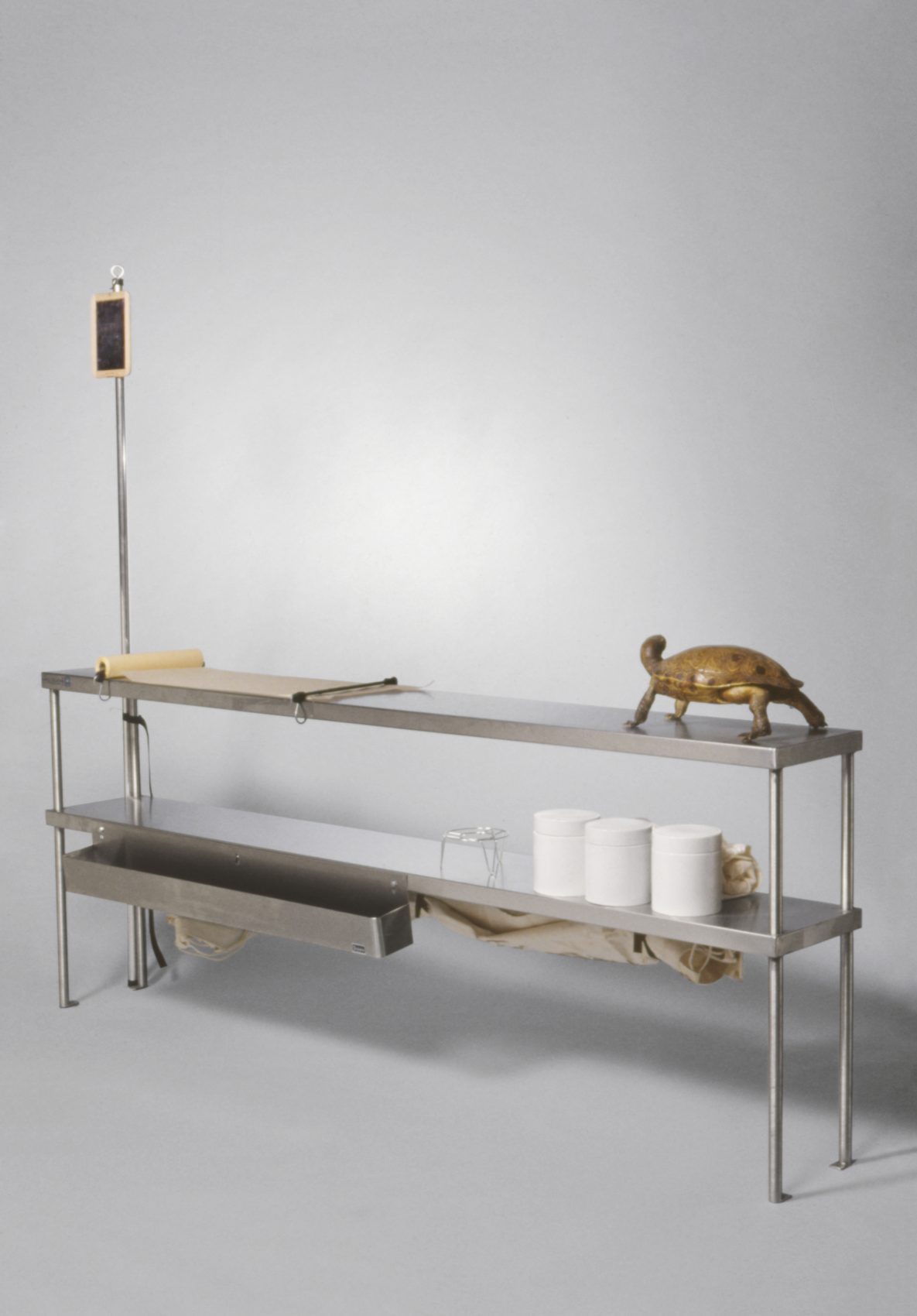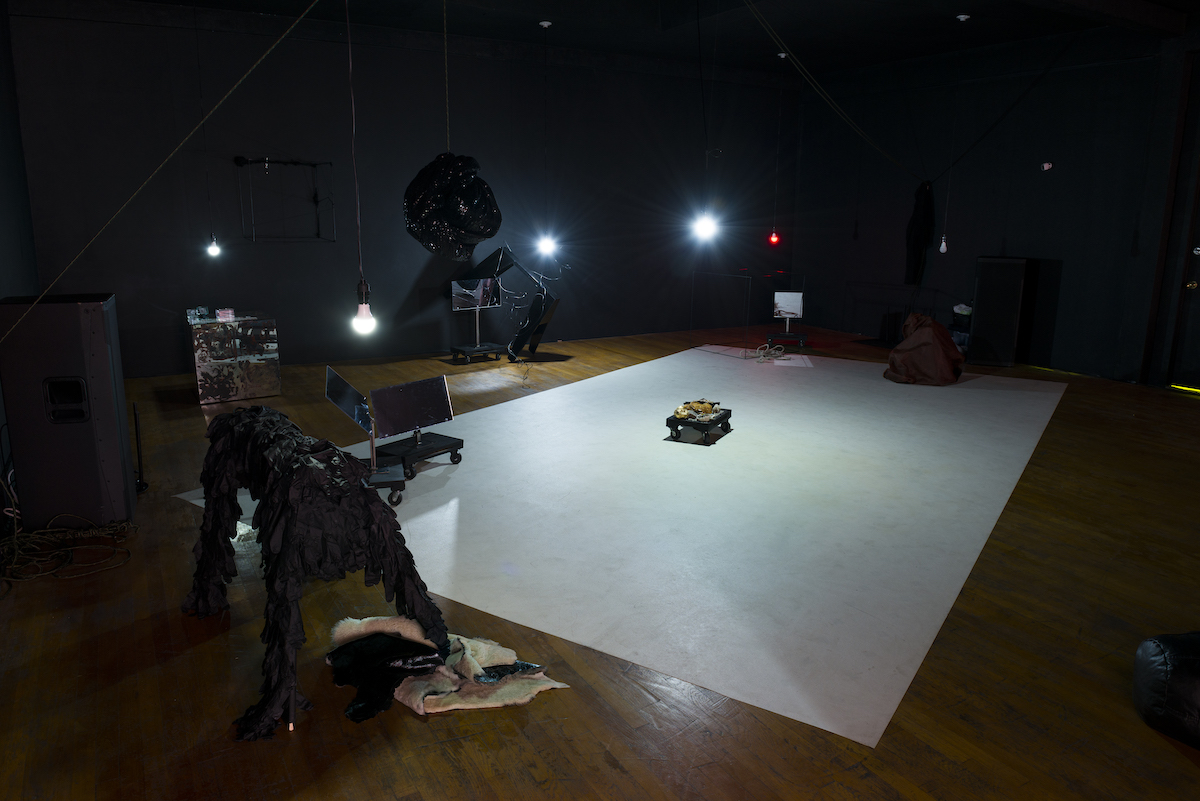The gallery was never still: for the duration of REPEATER, Julie Tolentino’s second exhibition at Commonwealth and Council, the artist inhabited the space every Thursday, Friday, and Saturday from noon to six. These 108 hours of live action took place in a darkened, aromatic room arrayed with prepared objects: a sawhorse armored with black latex gloves, angled mirrors on casters, a swatch of white carpet. A looping black and white projection of a glacial landscape lit one side of the scene and a lone bulb at chest height illuminated the center. Sometimes, Tolentino wore a shapeless, sequined cloak, like a headless creature. Every hour, she cut herself, ritual incisions indexed by glass microscope slides bearing her blood. Still recovering from her undertaking, Tolentino spoke with artist and writer David Muenzer about marking grief and feeling alive.

Julie Tolentino, REPEATER, 2019. Performance still, Commonwealth and Council, Los Angeles, September 21–November 2, 2019. Photo: Ruben Diaz.
JULIE TOLENTINO: There are always private things happening in public. When we can go through life with openness to our own senses, we witness this disclosure of self in others as well as perform that disclosure. Rigging REPEATER in a way that reveals small objects and actions—that’s political.
DAVID MUENZER: In contrast to the shift towards an experience economy, where there’s so much emphasis on having something happen, at a certain time, for a set purpose.
JT: Unfortunately, I’ve lived through that devouring neoliberal shift my entire adult life. In response, I try to incorporate history in my movement practice, activism, and experiences of caregiving. I’ve been really close to others at the end of life, so I try to find language about this nearness with someone, our multiple losses. People talk about ACT UP, or they talk about SM or body modification, or being queer, being subversive or transgressive, but those things often get flattened. I look for small moments of intimacy, ways of sensing or letting someone sense you.
DM: Being seen, or pleasure in seeing another—you seem to have a more mutualistic understanding of that encounter, which is so different from a value-based relationship between a performer and an audience.
JT: The mirror is the repeater of the title. All of the mirrors tilt down—towards the grassroots and the on-the-ground. There’s no score. I was trying to wrestle with the stealthiness of loss. There are no set actions, you do your best, you’re stuck with exactly who you are in that moment. And along with that, there’s a general problem of how to attend to the space. Specifically, in REPEATER, it was key to work without feeling the pressure of performing for someone. Much of the time, I wasn’t completely aware that people were watching, because I was absorbed in an action or physically obscured by or engaged with one of the elements.

Julie Tolentino, REPEATER, 2019. Performance still, Commonwealth and Council, Los Angeles, September 21–November 2, 2019. Photo: Ruben Diaz.
DM: The inward nature of the performance was something I took away from the experience. You have a recollection of everything you undertook, but no one else has such a recollection. No matter how long a viewer might stay on a given day, they could never get close to a whole picture of the actions that took place over the total 108 hours. And in some cases, like the cuts, you experienced sensations that can only be perceived by a potential audience member in a very different way. The part of me that has critical distance tried to categorize the thorough, private nature of this work. I thought about how a research scientist might execute tasks that are complicated, long-term, and solitary, but which will eventually be shared in a graph or paper. And then another part of me thought that critical distance was absolutely beside the point.
JT: If the work is doing the work, it’s doing what you’re talking about: giving us all this time to think, to be, to take time. It’s for you and us. I love watching people think. When I’m watching you think, I’m probably falling in love, just a little tiny bit. There is something about giving time, about watching that kind of unfurling. People come to me with the question, “Well, what was it like?” and I have to say, “Ask someone who was there.” Over the years, hundreds of people have seen these performances! REPEATER has many parts that will not exist materially outside of the space and time of the Commonwealth and Council show, and there are other elements to gesture to the whole, too: the video, the glass slides of my blood, the works that carry through and morph from one iteration to the next. And in the space, it isn’t only visual: there’s sound, you can smell and carry away the scent. You can sleep on the pillows.
DM: It is very inviting.
JT: Ideally, people would walk through it as an exhibition. But I made a kind of trap for myself, because, well, there were objects offered for sitting, resting, hanging out. So, you’re invited to sit down. But that creates a front.
DM: If you sit, you face one way.
JT: I tried to offset that frontalness by putting down a section of white flooring to divide the space along a diagonal. The movement happens around, falling from, and through the diagonal, as much as on it. It’s not trying to be a stage.

Nayland Blake, Work Station #6 (envy), 1990. Steel, canvas, ceramic, tortoise, and slate, 84 x 12 x 33 in. © Nayland Blake. Courtesy of Matthew Marks Gallery.
DM: It was a prepared environment. I was thinking about different kinds of carefully laid-out environments and Nayland Blake’s “Work Station” series came to mind. I also thought about the way a chef works—the concept of mise en place, where all tools must be at the ready—and craftspeople who participate in a tradition and feel alive and relate to one another through working with a tool or treating their traditional implements with passed-down forms of respect.
JT: That’s wonderful.
DM: In your space, some things moved and others didn’t. How could one not be attracted to the movement? Life seeks life…
JT: Even the lighting moved, which I had programmed. But I learned the patterns quickly, so what I would have to do is, every day, kind of blindly re-pattern it. Over the six weeks, the layers of patterns would start to counter themselves. The room was offering up problems.
DM: That seems like a positive!
JT: It was! Then sometimes it just broke my heart, like when I ended up separated from my glasses in the dark. It was like the room became weighted, off-kilter, or visually vocal. This imbalance led me to try and work decisions out in real time. If I put a mirror at a certain angle, I can see a previously hidden element, and so can the audience. It was good to be able to create a way to see the movement from the back or from another position, doubling it. I hope the unruly, live moment becomes the way to express multiple points of experience. This focus on multiple perspectives also included inviting guest artists to take part via sound, writing, or movement. There are forms of advocacy at work—that of the artists to whom the work is dedicated as a requiem, as well as fellow artists working with me. There is something about sharing those special live moments, like when you love somebody, or you love someone’s work and want to share. Or the fact that Nayland hasn’t cut his hair for X amount of years. The work includes these feelings that I have and these facts that I know, even if indirectly. Maybe that’s another way to conceive of advocacy, at least in part.

Julie Tolentino, REPEATER, 2019. Performance still, Commonwealth and Council, Los Angeles, September 21–November 2, 2019. Photo: Ruben Diaz.
DM: I like that, in terms of thinking about repositioning the mirrors and sharing a point of view. The way a mirror works, of course, everything is relative, so the reflected image also discloses the positions of the viewer and the things seen. I think advocacy is a nice word for that relationship in your performance. Using the mirror to share your observations of the unpredictable scenarios you laid out, and to lend a hand to small moments, helping them to become visible. But against the current of that fluidity, I kept thinking about the timekeeping. You know, your hourly cutting action. Did you keep body-time for every hour or did you observe an external clock?
JT: No, I had a clock. I set my phone to play a Princess Nokia song every hour, which was another subtle sonic texture. I’ve been performing using blood for many years, but this work involves self-cutting, which is different from other works. Either way, whenever I work with blood I work in red light to keep the focus on its sexual origins, as a libidinal and affective practice. I’m not interested in the “natural Pieta look.” I’m more interested in, for instance, the anticipation or the relief of the needle or the timing or presence of a cut, rather than its bleeding. I appreciate that we all share questions about what took place. “Was it too deep? Is it going to bleed?” Maybe that’s true in general—the motions and questions are much more interesting than the fixed object. X

Julie Tolentino is a Filipino-Salvadoran artist whose practice explores duration, movement, and sensuality. Tolentino is the editor of Provocations in The Drama Review, and has led queer club spaces such as Clit Club, Tattooed Love Child, and Dagger at various locations in New York City throughout the 1990s. She was a member of ACT UP NY, Art Positive, and House of Color Video Collective, and, with Cynthia Madansky, co-created and distributed the Safer Sex Handbook for Women for Lesbian AIDS Project/GMHC.
David Muenzer is an artist and writer. He formerly co-directed the space Full Haus. His exhibition Sylvan Plug is on view at Jan Weenix in Altadena through February.